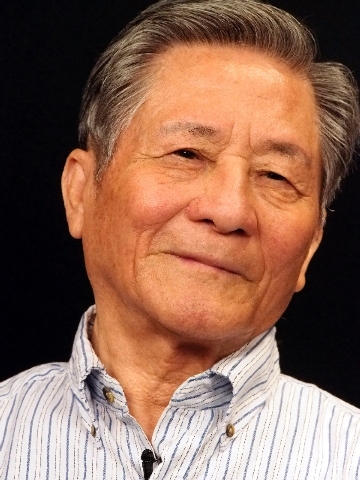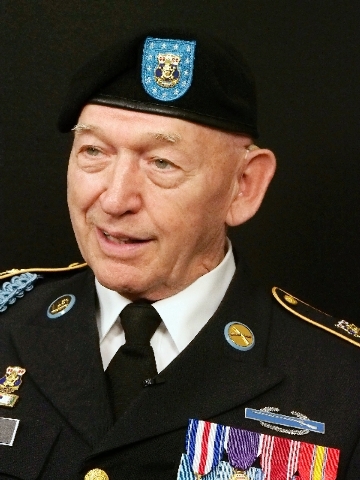Friendship forms between pair from different sides of the war





They live by the adage that “time heals all wounds.”
They’re just glad to be alive and be friends, 60 years after they served in opposing armies on distant Korean battlefields.
Former Army Pvt. Warren “Gene” Sessler fought in the trenches of the Iron Triangle, where hand-to-hand combat was sometimes a way of life.
T. I. “Donald” Hahn spent most of his time in prison camps, where surviving meant enduring starvation, beatings with sticks, and stone-throwing riots.
Now 85, he was a medical student who was drafted while going to college in Pyongyang, the capital of North Korea.
Sessler, 79, inspired by the World War II heroics of the legendary Audie Murphy, volunteered for combat. As an 18-year-old rifleman in Charlie Company, 15th Infantry Regiment, 3rd Infantry Division, the soldier from Detroit fought in one of the last and most decisive battles of the war: the Battle for Outpost Harry.
And for his gallant June 11, 1953, actions to hold the hilltop outpost “at all costs” from being overrun by communist Chinese soldiers, he was awarded the Silver Star.
Hahn, on the other hand, surrendered early in the three-year conflict while hiding in a bomb crater near a rice paddy where hundreds of his fellow soldiers had been killed by artillery strikes and strafing from U.S. aircraft.
“The sounds of fighter planes’ massive air raids, tank machine-gun fire and artillery shell blasts surrounded me, ripping out my ear drums and numbing my head,” he wrote in his book, “Memoir of Korean War POW.”
He spent 33 months in prisoner-of-war camps and became a commander of anti-communist captives.
Both Hahn and Sessler endured life-changing experiences and survived many brushes with death. Now, they both live in Henderson.
And on this Memorial Day, they will remember the “Forgotten War,” friends lost and freedoms preserved.
HELPFUL HANKY
It was a teary farewell at the Hamheung, North Korea, rail station as Hahn’s mother handed him a white handkerchief before he boarded a train with 120 classmates. She told him to use it to wipe the sweat as he trained to fight advancing U.S. forces.
At first he refused it. He later realized her instinct had saved his life.
With thousands of North Korean soldiers dead or wounded from their retreat north of Pyongyang, Hahn had somehow managed to dodge the bombs and bullets. He recalled in a recent interview that he was hunkered down in a crater along the highway near a rice paddy when his moment of truth came:
“I looked up the road, and there are tanks coming, many tanks. I think that it is time my mother’s handkerchief should come out. I have to surrender.”
He tied the hanky to the tip of his rifle and started waving it. A soldier saw him, he said, and “I started coming out.”
But he didn’t raise his hands and the tank’s machine gunner opened fire. A bullet pierced the flesh of Hahn’s leg as he ducked back into the crater.
“I shake my white flag harder,” he said. “This time he stops. I put my hands up.”
Hahn’s POW odyssey began that rainy Oct. 19, 1950, morning. After five days, he was sent to a prison in Pyongyang, after U.N. forces had taken over the city.
“They gave us a rice ball to barely keep us alive,” he said.
His next stop was the port of Inchon, 40 miles west of Seoul, South Korea, where a couple thousand POWs were crammed into the hold of a coal freighter for a three-day trip to Busan. About 100 prisoners died, he said. The remainder were marched to Busan Seomyon POW camp, to work as laborers at an airfield.
“At the work site, the GIs kicked and hit us hard with sticks and gun butts, yelling, ‘huba, huba,’ ” he said.
The death toll alone from disease and dismal living conditions would sometimes reach 100 a day, he said.
From there, prisoners were sent to Busan Koje-ri Compound, “where we almost became living corpses.” Because he could speak English, he became a translator and POW leader. He worked in compound headquarters and became friends with a U.S. Army sergeant, who made sure he got enough food to recover his body weight.
In early 1952, tens of thousands of North Korean and Chinese POWs were moved to camps at Koje-do, near Busan. Hahn was put in the Red 76th, a riot-infested compound with communist prisoners. Through the fence one day he saw his old friend, the Army sergeant, who this time arranged for Hahn and 100 anti-communist POWs to be transferred to the 83rd Compound.
“He saved our lives,” Hahn said simply.
Later, hundreds of prisoners who wanted to go back to North Korea were massacred by other prisoners opposed to their decision.
“Armed with clubs, steel pipes, knives, and pick axes (they) started to beat and kill those POWs,” Hahn wrote in his book.
With U.N. and North Korean-Chinese negotiators in a stalemate over repatriation of POWs, South Korean President Syngman Rhee secretly arranged an escape for anti-communist prisoners.
On June 18, 1953, military police cut the barbed wire on the compound’s east side, allowing Hahn and hundreds of others to run through the night to Busan, where they were welcomed into the homes of South Koreans.
Hahn reflected on his thoughts at the time: “I’m free now.”
OUTPOST HARRY
On the same night that Hahn ran to freedom, Sessler was recuperating from shrapnel wounds and a dislocated shoulder he sustained in the weeklong Battle for Outpost Harry.
He explained in a letter to his parents that after being a truck driver, transporting ammunition to the front lines, he had volunteered to be rifleman in Charlie Company’s 1st Platoon.
Outpost Harry was the tip of a trio of positions. The others were named Tom and Dick. It had been fortified with trenches and deep bunkers topped with timbers and sandbags to withstand the constant barrage of mortar and artillery fire from the Chinese stronghold on Star Hill. It was the work of then-Maj. John K. “Jack” Singlaub’s battalion. Singlaub, who became a well-known major general, was commended with a Silver Star for a previous fight to hold the hill.
The enemy and friendly positions were separated by a small valley. Hundreds of Chinese soldiers would cross it to overrun the ridge manned by only a company of 15th Regiment soldiers and their U.N. partners from Greece. The seesaw battle to hold Outpost Harry was vital to keep the Chinese from having an upper hand in the stalled negotiations for returning POWs. On the night of June 10, Sessler’s Charlie Company had been staged at the bottom of the hill to launch a counterattack.
“As we started up Harry, dead men were all over the place and shells were coming in. I got awful scared and I always had been afraid of dead people and here they were in piles,” Sessler wrote in the letter to his parents.
“I got sick from the smell and the pleading of the wounded. By this time we were at the top and we opened up with plenty of machine guns and the (Chinese) started down the other side.”
In an interview nearly 60 years after the battle, Sessler recalled the horror that happened in the early morning of June 11, 1953.
“It was dark except for the flickering flares. Everything was shadowy, shaky. Sometimes you could see clearly, then it would dim out,” he said, describing the “helpless military situation” and the unbearable odor from corpses left from previous encounters.
“I had been well-trained at infantry school at Fort Benning (Ga.), and one thing you want to do when you are caught in the open is move no matter what.”
His squad was pinned down by a horde of Chinese soldiers in a machine gun nest.
“So I called the men around me and I said, ‘Anyone staying here is going to be killed.’ I said, ‘Let’s give it a try,’ and I had a partner, my good friend Perry Browning from Mobile, Ala. We were very close.”
Sessler grabbed a Browning Automatic Rifle, “and he took the M-1 rifle, and we charged up the hill as far as we could with everyone shooting at us.”
His Silver Star recommendation tells the rest.
“When his squad was halted by intense hostile machine gun fire, Pvt. Sessler, with complete disregard for his personal safety, crawled to within feet of the enemy’s position, lobbed grenades into their midst and dispatched them,” the recommendation reads. “Returning to his squad he proceeded to drive the remaining from the friendly trenches and bunkers. He remained on the knoll throughout the siege, until assured that the foe had been driven off.”
By this time, Sessler and Browning had run out of ammunition.
“I put him in a bunker and showed him how to sandbag it. I said, ‘There’s nothing you can do. I want you to stay protected. Don’t come out for any reason for anybody until you can finally determine it’s me,’ ” Sessler said.
Sessler then went to help the seriously wounded soldiers and commanders and locate what would be the remaining 22 survivors of his platoon of 50.
He finally went back to the bunker to look for Browning. The sandbags had been moved, Sessler said: “I looked inside and there was a leg only. There was a uniform and boot on. So obviously if it was Private Browning. He was dead.”
SMOLDERING CONFLICT
During the Battle for Outpost Harry, more than 800 U.S.-led troops staved off 15,000 Chinese soldiers, killing 4,200 of them.
“We lost 174 soldiers,” Sessler said, but most who survived were wounded.
By the time the July 27, 1953, armistice was signed, an estimated 37,000 U.S. military personnel had died in Korea. The conflict smoldered, and Sessler wonders whether it will ever end.
“I’ve been thinking about it for 60 years, and nothing ever changes. I don’t perceive in my lifetime that there will ever be any breakthrough on either side to make this happen,” he said. “North Korea seems very belligerent at times, but each time it’s always been proven they’re bluffing.”
Hahn went on to serve in both the South Korean army and U.S. Army, where he worked as an interpreter and investigator for the 8th Army. He moved to the Las Vegas Valley in the 1970s and worked as a dealer at the MGM Grand.
Sessler started a movie prop business for military themed films and, through Hollywood channels, he got to know his hero, Audie Murphy. After Murphy was killed in an airplane crash in 1971, Sessler was a 3rd Division pall bearer for his burial at Arlington National Cemetery.
Sessler later moved to Henderson and sometimes traveled to China on business trips. That’s where he met his wife, Xiao, a Chinese national who became a U.S. citizen and Army Reserve lieutenant. She served in Afghanistan last year with a civil affairs company, the Vegas Desert Rats.
Henderson is also where Sessler met Hahn, in 2009 through an acquaintance at the latter’s church.
They became good friends, and military historian Sessler even wrote the foreword to Hahn’s book, published this year.
For, as Sessler said, “We both beat the odds.”
Contact reporter Keith Rogers at krogers@reviewjournal.com or 702-383-0308.












